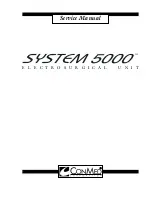
3-6
the Control board, along with circuitry to isolate
them from RF noise.
• System Controller (System Microcontroller):
A dedicated microcontroller that handles the
entire user interface, Serial Interface, real
time clock functions, and enables/disables the
power factor control section of the HVPS
using the PFC_EN signal. The System
Controller can also disable the signal used to
drive the RF Amplifier and can terminate RF
drive at any time without interaction from
either the RF Controller or the Monitor. The
System Controller is comprised of an standard
architecture microprocessor together with
Field Programmable Gate Array (FPGA),
which provides interface logic to a variety of
signals, a 3.68MHz oscillator, independent
voltage regulators, a processor supervisory
reset circuit, and other interface logic.
• RF Controller: A DSP that is dedicated to
the output and control of RF power using
the DAMPCNTRL and RF_DRV outputs.
To reduce the effects on the microproces-
sor circuits on the Controller board from
RF noise at the output, DAMPCNTRL and
RF_DRV are both differential mode signals
running between the RF Controller and the
RF Amplifier. The RF Controller is capable
of disabling RF output power and put-
ting the system into a safe state without any
interaction from the Monitor or the System
Controller. The RF Controller indepen-
dently monitors the RF output voltage and
current for control purposes through several
scaled inputs. It sets the output voltage of the
HVPS using the HV_SET signal dependent
on the output Mode and power selected. The
RF Controller controls the fan based upon
temperature measurements supplied from the
RF Amplifier through the System Controller.
The RF Controller is comprised of a DSP,
together with circuitry necessary for convert-
ing the signals used for control purposes
between analog and digital form, independent
voltage regulators, and other interface logic.
• RF Monitor: A DSP that is dedicated to safety
monitoring activities. The Monitor is capable
of disabling RF output power and putting the
system into a safe state without any interac-
tion from the RF Controller or the System
Controller. To ensure that the Monitor can
correctly perform its function, the Monitor is
resistively isolated from the other two proces-
sors and has independent voltage regulation.
The RF Monitor independently monitors a
variety of inputs to detect safety problems
and has control of disable signals for both the
HVPS and RF Amplifier drive. The Monitor
is comprised of the same DSP as the RF
Controller, together with circuitry necessary
for converting the signals monitored between
analog and digital form, an FPGA to provide
interface logic, independent voltage regula-
tors, isolation resistors and other interface
logic.
3.2.8 Low Voltage Power Monitoring
The low voltage power supply is monitored in
hardware and resets the processors if it is out of
range. The microprocessor supervisory device on
the Controller board mo5V and +3.3V
and will reset the system should the levels drop
approximately 0.3V. The Controller assembly
has the circuit that will reset the system should
the 3.3V supply exceed 3.6V. The High Voltage
power supply has a circuit that will inhibit HVDC
should the +5V supply exceed 5.7V.
3.2.9 Operator Control Panel
Keyboard: The main operator input device for
choosing operating modes and settings is the
membrane keyboard panel. Tactile-feedback
mechanical switches allow the operator to set
modes and adjust power settings.
Display Panel: Consists of 7-segment displays,
discrete dual colored LED’s, and light bars that
will display all controls and settings. LED display
elements are illuminated in a time division multi-
plexed fashion; the illuminated LED display ele-
ments are actually on less than half the time.
Bipolar Current Meter: The System 5000™
has a bargraph display that provides an indica-
tion of measured bipolar impedance. A special
tone works in conjunction with this bargraph to
indicate when the measured bipolar impedance
exceeds a particular limit.
3.2.10 Activation Tones
Tone is generated for all activation requests, fault
detection and changes made on the Control Panel.
The System Controller generates the tone signal
(ACT_TONE, AL_TONE, & BP_TONE), which
is amplified by a driver on the Backpanel PCB
Assembly. The activation tone and bipolar tone











































